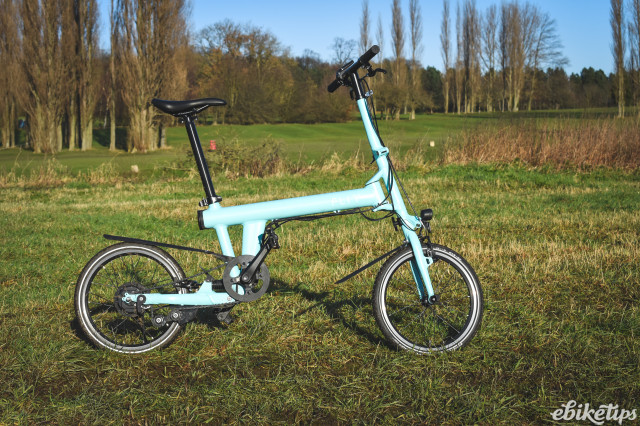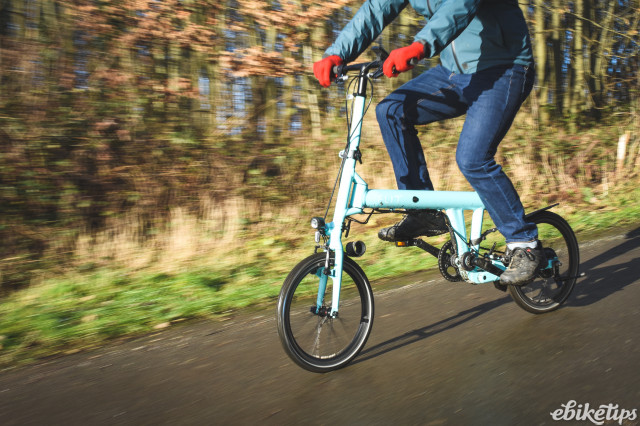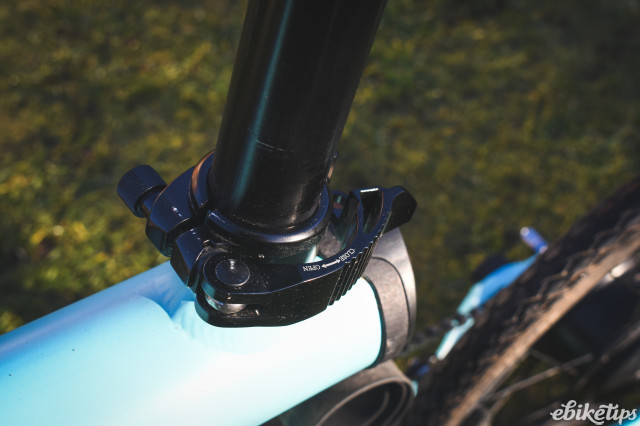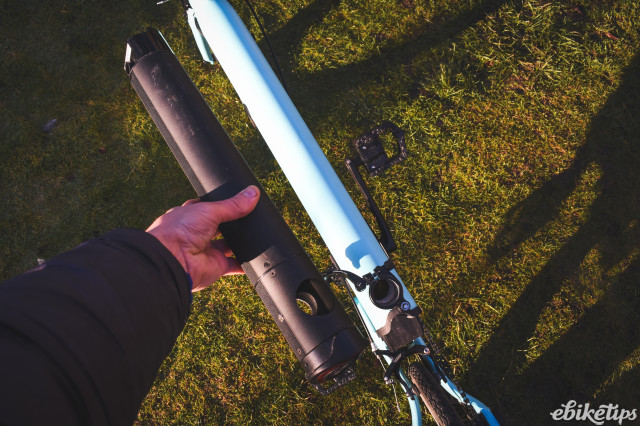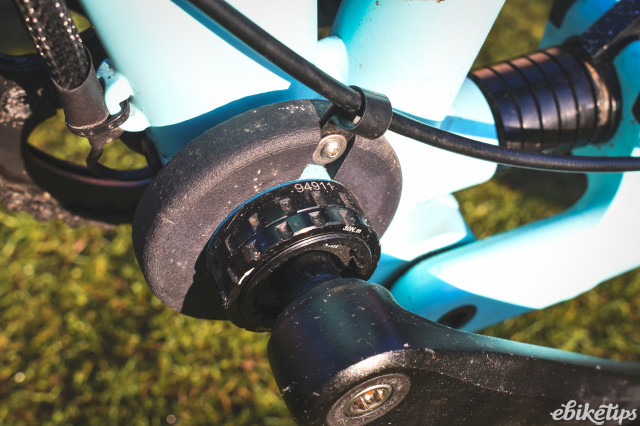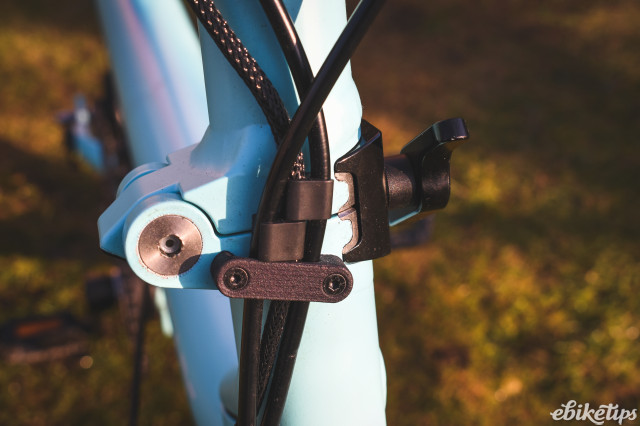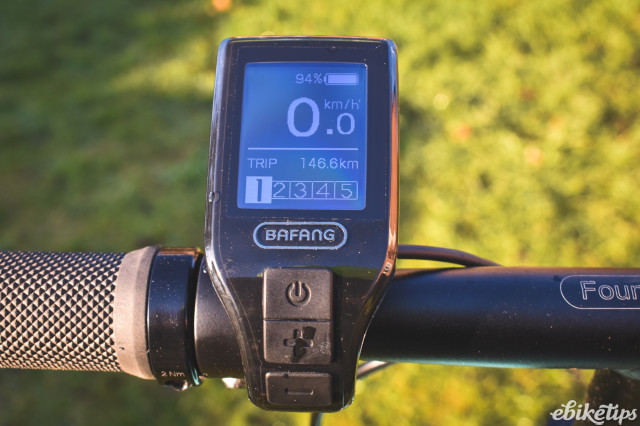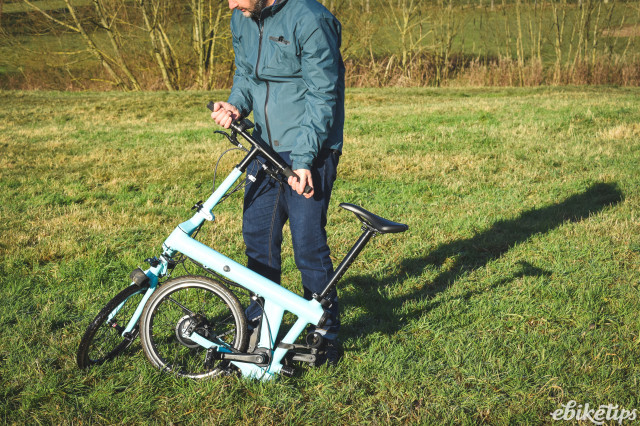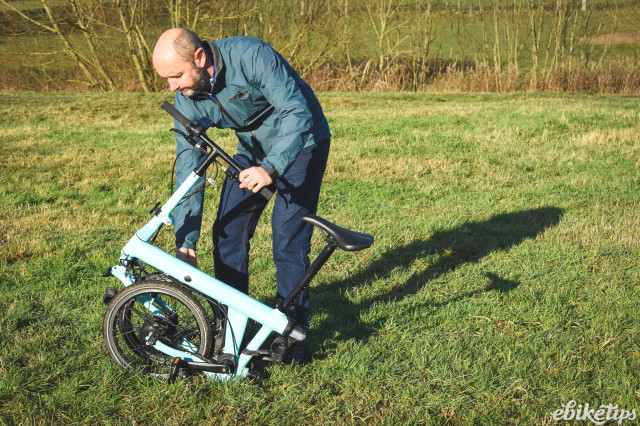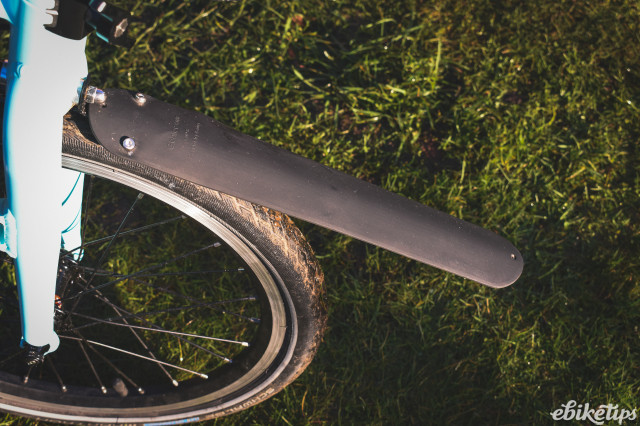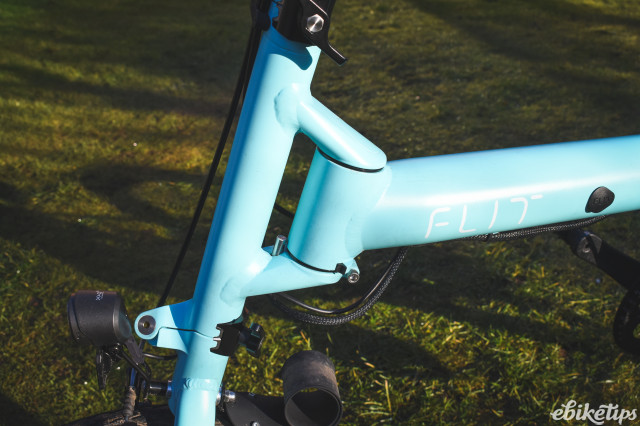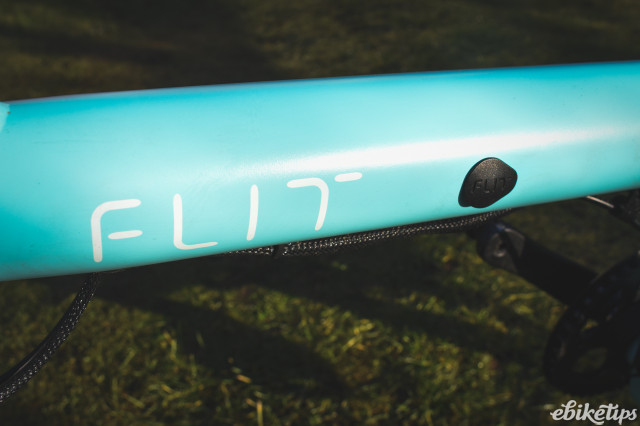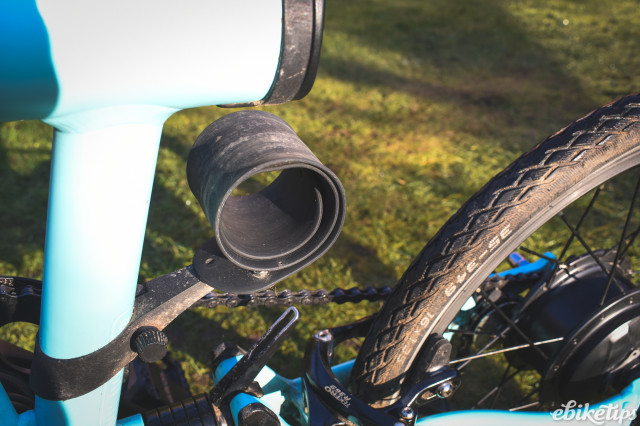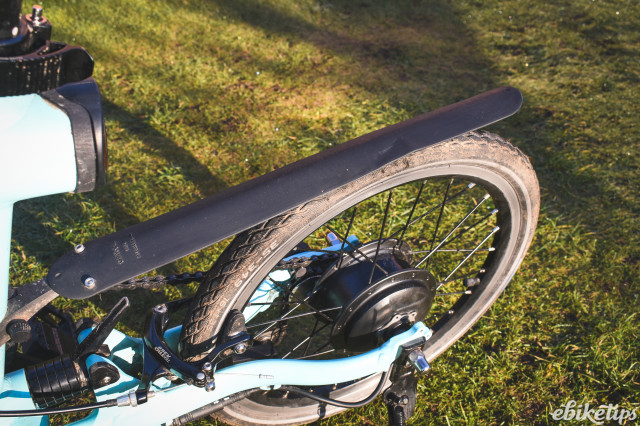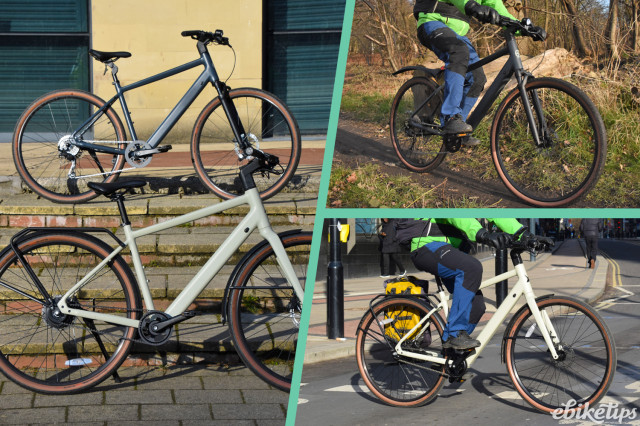Review: FLIT-16
Overview
- Pretty lightweight for an electric folder
- Folds quickly and neatly
- Fast and efficient to ride with decent hill climbing, despite the single gear and small motor
- No option currently to add gears or disc brakes
- Slightly limited luggage carrying options
- Fuller length rear mudguard advisable in wet and mucky conditions
Ebiketips took a pre-production look at Flit 16 back in August. The back story is all there, from designing from scratch, through crowdfunding and appearances in the Eurobike awards.
We had a brief test ride back then and felt the Flit-16 looked like it could be that rare thing; a light, compact folding e-bike with decent performance and range. Existing e-folders tend to be heavy, and even if they are light by non-folding standards still a bit heavy to lift easily onto a train luggage rack or into a car boot. Even lighter models of electric folder are usually well over the 16kg mark, so the 15kg+ Flit-16 seemed to promise a good compromise between the difficult trade-offs of weight vs performance vs price that are ever present when looking at electric folders.
Naturally we were really excited to have a full production sample dropped off, complete with mudguards and kickstand, so we could see if a full road test delivered on that promise.
Design and Spec
The design integrates a 230Wh battery into a cylindrical aluminium mainframe and a very small, neat-looking Bafang hub motor into the rear forks. The rest of the design is rather dictated by the bike’s ‘tri-fold’; the rear forks swing under the main frame and when unfolded rest on elastomer discs, whilst offsetting the front forks allows for the insertion of a hinge in them, so that the front wheel ‘rolls and folds’ back along the side of the mainframe, with the handlepost dropping down between mainframe and front wheel.
This produces a neat folded package that we measured at some 730mm (l) x 680mm (h) x 335mm (w) – not quite in the same class as the world beating Brompton’s 600mm x 595mm x 280mm but still one that can be handled reasonably easily and just as importantly stays firmly locked together when carried about. This is achieved in roughly similar fashion to the Brompton in that front forks hook onto the rear forks with the whole package effectively locked together with a final lowering of the seatpost.
Our timed test comparing a FLIT fold-unfold cycle to a Brompton’s showed little practical difference, taking around a minute for each bike; quick-folding maestros will no doubt scoff that they could halve that. The FLIT’s excellent spring-tensioned hinge clamps were always ready to go whilst the Brompton’s took some fiddling but the FLIT’s front wheel fold needed a bit more of a refined technique than the Brompton’s. Both folds were fast and easily accomplished. The Brompton is nicely balanced when carrying by the saddle but the FLIT less so and tends to nosedive towards the ground – that could easily be remedied with a fabric mid-frame carry handle that would add next to no weight.
Just as notable as the FLIT’s neat and compact fold is the quality of the design and manufacturing. The hinges are steel reinforced and like everything else on the bike look accurately made and strongly designed and constructed; parts like this need to be, to stand up to the repeated stresses and strains of a folding bike in continual commuting use.
The battery is removed by simply sliding out the seatpost allowing you to pull the battery out of the rear of the frame. If it were me I would be tempted to leave the battery in situ (there is a charging port in the frame), thus avoiding the possibility of dragging dirt into the seatpost housing and possible scoring of the seatpost. If leaving the bike parked there is neat little lock that locks the seatpost in place, preventing battery theft.
It’s a single-speed design so there is little so say about the gearing and there is a Tektro front V-brake and Tektro R369 rear dual pivot brake.
Lighting is courtesy of a fairly powerful Spanninga X&O front LED and an own brand rear light neatly doubling as the rear face of the battery. The system is hardwired to run off the main battery and has an auto-sensor so it comes on in low light levels but this can be fine tuned for sensitivity.
Rims are Brompton size (349mm) rather than the even smaller Dahon style 305mm and so there is plenty of choice in Brompton-sized tyres if you want to swap the standard issue Schwalbe Marathons – anything from fast Schwalbe Kojaks to the superb Schwalbe One or even studded winter tyres. A kickstand and Genice ‘rollup’ mudguards (both optional) completed our review bike.
Performance
Our test riding wasn’t really the typical city commute that the FLIT is designed for, comprising socially-distanced and pretty hilly riding in the quiet Pennine countryside. Still, the FLIT came out with flying colours and showed just what can be achieved with a motor that is geared for high torque along with singlespeed pedal power that comes into its own at higher speeds once the motor has done the hard work; our test model had a 38T front chainring and 9T rear sprocket, in practice topping out at a little over 16mph, ideal as that is of course around the legal cut out limit of the motor system. We didn’t find a hill that defeated the small single gear setup but some required rather more standing out of the seat and stepping hard on the pedals than others. Without the help of the motor though these weren’t even something we would have attempted on a similarly geared bike. It looks a fairly straightforward mod to alter the size of the chainring if you want to make the bike harder or easier to pedal.
A good range of rider sizes are catered for with adjustable seatpost and handlebar height and there is the option of a longer seatpost for much taller riders. FLIT say the bike will fit riders with inside legs between 62.4cm to 91.5cm and max rider plus luggage rating is 100kg.
The overwhelming ride impression is of something stiff and fast like a road bike and we couldn’t detect any great effect from the elastomer suspension. Although this meant it wasn’t the most comfortable over the humps and bumps it translated into a quick ride and no doubt helped return the extremely impressive range figures below.
Operation of the electrical system is pretty simple and the handlebar unit combining display and buttons is pretty good. Best of all it gives a percentage readout for the battery capacity so you can see just what remains and so are less likely to run out completely. There’s a very clear block display to show which of the five power levels you have selected and your speed is shown in large figures. Smaller type underneath the speedo lets you toggle through trip, odometer, max trip speed, average trip speed, estimated range, output power in watts, rider energy consumption in kilocalories and travel time.
There is also a USB charge point on the back of the unit for charging your devices on the go. That’s a superb range of functions on such a small unit, with current time the only missing field that would be truly useful. Working the buttons with thick winter gloves on was more fumble than finesse and larger more obvious rocker switch style buttons would surely be an improvement on an otherwise highly impressive design.
The bike completed a 20 mile hilly ride, scrolling up and down the power levels as required, with well over 30% battery capacity left, suggesting 30 miles was within its capabilities even in such hilly conditions and 40 miles entirely feasible for my 68kg frame over more benign topography. These are some of the best figures we have seen for a battery this size, and testament to the efficiency of both the bike itself and the way the impressive Bafang system assists too. No doubt the double-sided torque sensor helps too in delivering some of the smoothest and most sophisticated power we’ve come across. If you want to ride all day then extra batteries are available for £249.95.
It was also one of the quicker small hub motor models on our mile long hill climb test, falling just below the GoCycle and most mid-drives and on a par with the Brompton Electric.
Whilst the assist system doesn’t give a super quick take off from a standing start, even on the top power setting, it is certainly effective for hill and traffic-light style starts – something the likes of the current Gocycle and the Cytronex Brompton retrofit kits lack (they both have a ‘safety delay’ so power only kicks in after a small time).
Our only other grumble on the motor front were the small amount of noise it emitted, though it was by no means distracting. A big plus was the fact it was nice and easy to pedal with power turned off, with no great friction from the motor itself, suggesting an efficient freewheel.
Leader of the Pack?
Is the FLIT-16 the best folding electric bike out there? There’s certainly a case to be made that it is. It’s lighter than most competitors with the exception of some Bromptons fitted with the likes of a Cytronex, Nano or Swytch and even then to substantially undercut the FLIT you would have to spec a smaller capacity, lighter battery or get a more expensive Brompton model that featured at least some titanium.
Performance wise it also competes well. Power delivery is as smooth as they come and equal to the Gocycle and better than the Brompton Electric. Folding is not up to Brompton compactness - that is a very high hurdle for any folder to scale - but the FLIT is a perfectly competent quick and light folder that beats most others. On our scales our test bike showed 15.77kg – slightly disappointing as the FLIT website quotes a weight of 15kg. That lighter figure is for a model without mudguards and kickstand which featured on our test bike (without mudguards and kickstand we weighed the bike at 15.35kg). There would also be the potential for any buyer to shave a few grams off by retrofitting lighter saddle, chain and pedals. But if you seriously struggle to lift the 15kg+ package then removing the 1.55kg battery is the easiest way to make it a more portable 14kg ish package.
In terms of extras we would at least offer the option of a fuller length rear mudguard – the innovative roll up Genice ones that came on the bike worked well to keep mud off the rider but the rear brake and chain tensioner area got well covered in crud even on a dry day encountering only the aftermath of some recent rain (albeit on relatively mucky country roads). It would need careful thought though to be compatible with the roll under fold of the rear wheel.
Compared to the bespoke front and rear luggage options offered by Brompton and Gocycle the Flit-16 is perhaps a little behind; FLIT say because of the the offset headset, putting luggage that weighs more than a few kilograms on the front of the bike can affect handling - handlebar bags are fine, but something like a bag on a Brompton-style luggage block (circa 10kg carrying capacity) would unacceptably affect handling in their view. However FLIT recommend a couple of seatpost/saddle attaching luggage solutions; these are the Frost+Sekers Otis bage (16 litres) and various Carradice options (up to 23 litres), both of which have quick mount/removal systems available.
The current price of £1999 offers decent value given the high quality of design and manufacture and the impressive performance, though it may well rise substantially as the bikes are rolled out through dealers. The current price certainly undercuts FLIT’s main rivals - the Brompton Electric and the Gocycle - by some way.
There is a three year warranty on the frame and a two year one on the electrical system – you might expect a longer frame guarantee perhaps.
Overall, the FLIT-16 represents an extremely impressive debut for an electric folder designed from the ground up – no easy challenge but one the FLIT has tackled cleverly and stylishly.
1 comments
I was really happy to have my Flit bike, in bright tangerine orange, arrive a few weeks ago. Due to lockdown and the weather I've not had much cause to ride it yet apart from a couple of test spins, but the main thing I love about it is the intelligence of the design - the fold method with the offset headtube is brilliant, the battery in the main tube works perfectly and is basically invisible. After just a little practice I take about 30 seconds to unfold it and slightly more, maybe 40 seconds to fold it again (getting the front wheel to hook on is a knack). The motor is 'enough' - and I've found the single gear just fine for skimming along at 25kph on the flat.
As for shortcomings - with the narrow bars the steering is very 'alive', and obviously the small wheels make the ride a bit more jiggly than a 29er on fat rubber, though it's not uncomfortable. I also agree the rear swingarm/brake/elastomer unit is exposed to spray from the rear wheel, but short of fitting rigid (and strong) guards like a Brompton there's not really a solution to that.
Basically, I love it and wish I had a reason to commute on it every day...

